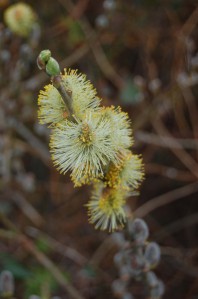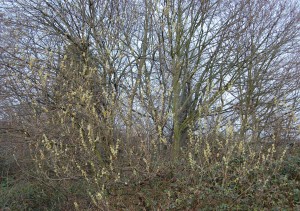Position: Full sun.
Soil: Moist but well drained.
Flowering period: Early spring.
Eventual Height: 10m
Eventual Spread: 8m
Hardiness: 5a, 5b, 6a, 6b, 7a, 7b, 8a, 8b, 9a
Family: Salicaceae
Salix caprea is a deciduous tree or shrub with a bushy habit. The leaves are oval, dark green above and grey beneath. The species is dioecious with male plants displaying catkins (pictured) that are grey with yellow anthers whereas the female catkins mature to a bright green.
Salix caprea, commonly known as Goat Willow or Pussy Willow, is a native Europe (including the UK and western central Asia. As the wood of S. caprea is too brittle to work and will crackle violently if burned has not been recorded as having many historical uses by man besides as a browse for goats.
The etymological root of the binomial name Salix is derived from the old Latin name for the willow tree and is possibly derived from the old Celtic sal ‘near’ and lis ‘water’. Caprea is derived from the Latin capra ‘she goat’.
Salix caprea is highly useful to the landscape architect as part of a native wildlife planting scheme. It is particularly useful in wet sites.
Ecologically, Salix caprea is attractive to moths and browsing mammals. S. caprea is also prone to aphids which in turn attract their predators leading to large and bio diverse habitat.
Salix caprea prefers moist, humus rich, soils. It tolerates most pH of soil. It will tolerate both waterlogged and dryer soils.
Salix caprea requires no regular pruning, if damaged branches need to be removed this should be done in late autumn.






Leave a comment